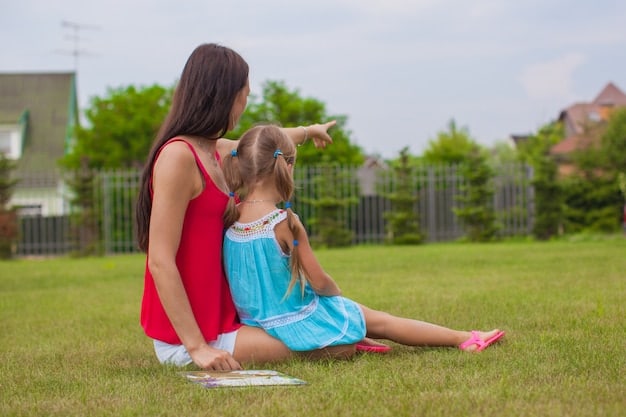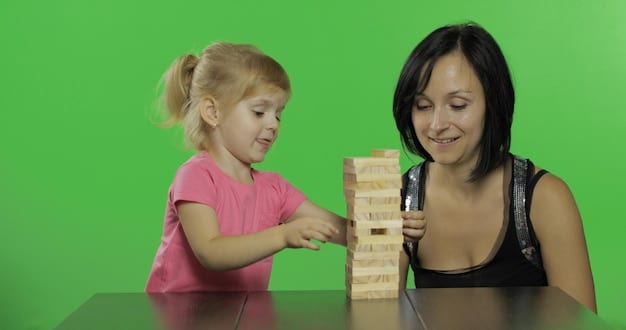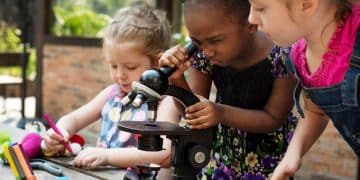Positive Discipline: A Guide to Shifting from Punishment to Guidance

Positive discipline offers a constructive alternative to punishment, focusing on teaching children valuable life skills, fostering mutual respect, and building strong, lasting relationships, which ultimately promotes lasting behavioral change.
Are you looking for effective strategies to guide your child’s behavior without resorting to punishment? Discover the power of positive discipline, a transformative approach that focuses on teaching, understanding, and building strong relationships.
Understanding the Principles of Positive Discipline
Positive discipline is an approach to parenting that emphasizes teaching children responsibility and self-discipline by using methods that are respectful, encouraging, and effective in the long term. It moves away from punitive measures and towards guidance.
It’s about understanding the ‘why’ behind children’s behaviors, addressing the root causes, and creating a learning environment where kids feel understood and supported.
Respectful Relationships
At the core of positive discipline is the principle of mutual respect. It involves treating children with the same consideration and courtesy that you would expect from them.
This means listening to their perspectives, acknowledging their feelings, and involving them in problem-solving, fostering a cooperative family environment.
- Active Listening: Pay attention and truly hear what your child is saying, both verbally and nonverbally.
- Empathy: Understand and share your child’s feelings by putting yourself in their situation.
- Collaboration: Work together with your child to find solutions that meet everyone’s needs.
Building respect in a relationship takes time and consistency, but this approach to discipline will enhance communication, understanding, and trust.

Long-Term Solutions
Positive discipline is not just about stopping misbehavior; it’s a proactive approach that builds essential life skills. It shifts the focus from immediate control to nurturing skills like problem-solving, self-regulation, and empathy.
It prepares children to be responsible individuals who can handle challenges successfully, and that gives them social skills valuable in all arenas of life.
By teaching children these skills that they can apply to any conflict or situation, the aim is to help kids become better equipped to handle difficulties, both now and later in life.
In conclusion, understanding the principles of positive discipline is about shifting from immediate reactions to thoughtful responses that teach, respect, and build lasting skills for children.
The Difference Between Punishment and Positive Discipline
One of the most critical aspects of changing your discipline tactics is differentiating between punishment and positive discipline. While both aim to correct behavior, they approach it from fundamentally different perspectives.
Punishment typically involves using shame, pain, or fear to stop unwanted behavior, while positive discipline focuses on teaching life skills and creating a cooperative environment.
Short-Term vs. Long-Term Effects
Punishment may provide immediate results by suppressing unwanted behavior, but it often comes with negative side effects.
Children subjected to harsh punishment may become resentful, fearful, or even aggressive, leading to damaged relationships and suppressed learning behaviors.
Teaching vs. Controlling
Positive discipline focuses on teaching rather than controlling. Rather than simply stopping a behavior, it aims to understand the underlying reasons for the behavior and teach the child how to make better choices.
This teaching process is about empowering children to think critically, solve problems, and take responsibility for their actions.
- Understanding Behavior: Identify the root causes of misbehavior, such as unmet needs or lack of skills.
- Teaching Self-Control: Help children develop the ability to manage their emotions and impulses.
- Promoting Responsibility: Encourage children to take ownership of their actions and make amends when necessary.
Positive discipline cultivates a supportive environment where children learn to self-reflect and adapt behavior appropriately.
To summarize, the core difference between punishment and positive discipline lies in their approach: punishment controls through fear, while positive discipline teaches through understanding and respect.
Implementing Positive Discipline Techniques
Implementing positive discipline involves a set of techniques that encourage cooperation, teach life skills, and foster a healthy relationship between parent and child. It’s about creating a nurturing environment where children can develop self-discipline and responsibility.
These techniques are designed to promote understanding, empathy, and mutual respect, which ultimately leads to more sustainable and positive behavioral changes.
Setting Clear Expectations and Boundaries
Children thrive when they know what is expected of them and when they understand the boundaries within which they need to operate.
Clearly defined expectations provide children with a sense of security and help them understand how to behave appropriately.
Using Encouragement and Praise
Encouragement and praise are powerful tools in positive discipline, reinforcing positive behavior and building a child’s self-esteem.
It is important to provide specific praise rather than vague compliments, highlighting effort, process, and improvement.
- Specific Praise: Instead of saying “Good job,” say “I noticed how hard you worked on this puzzle, and you solved it all by yourself!”
- Focus on Effort: Praise the effort and persistence, not just the outcome.
- Build Self-Esteem: Help children feel capable and competent by acknowledging their achievements.

Problem-Solving Together
Involving children in problem-solving helps them develop critical thinking skills and teaches them how to take responsibility for their actions.
When conflicts arise, engaging the child in finding solutions fosters a sense of ownership and encourages them to participate constructively in resolving issues.
Setting clear expectations, using encouragement, and working together to solve problems are vital for the successful implementation of positive discipline techniques.
Addressing Common Challenges with Positive Discipline
Even with the best intentions, implementing positive discipline can present challenges. It requires patience, consistency, and a willingness to adapt your approach as needed.
Understanding common obstacles will help you navigate them more effectively and stay committed to creating a nurturing and supportive environment for your child.
Dealing with Strong Emotions
Children often experience intense emotions, such as anger, frustration, or sadness, which can lead to challenging behaviors.
Teaching children how to manage their emotions is a critical part of positive discipline.
Consistency is Key
One of the biggest challenges in implementing positive discipline is maintaining consistency. It’s important for both parents (and any other caregivers) to be on the same page.
Inconsistent responses can confuse children and undermine the effectiveness of positive discipline strategies.
- Communicate: Discuss discipline strategies with your partner and other caregivers.
- Plan Ahead: Anticipate potential challenges and develop a consistent response plan.
- Re-evaluate: Regularly assess your strategies and make adjustments as needed.
By addressing strong emotions, maintaining consistency, and regularly evaluating your approach, you can overcome challenges.
When to Seek Additional Support
While positive discipline can be highly effective, there may be times when additional support is needed.
Don’t hesitate to seek guidance from professionals when needed.
Positive Discipline in Different Age Groups
Positive discipline adapts to the changing needs and developmental stages of children as they grow. What works for a toddler may not be effective for a teenager, requiring parents to adjust their approach to align with their child’s age and maturity.
Adapting positive discipline means staying attuned to your child’s growth and adjusting communication styles, expectations, and discipline approaches accordingly.
Toddlers and Preschoolers
For toddlers and preschoolers, positive discipline focuses on setting clear boundaries, redirecting behavior, and using positive reinforcement.
Toddlers benefit from simple explanations, consistent routines, and lots of encouragement.
School-Aged Children
As children enter school age, positive discipline methods can evolve to include more problem-solving and responsibility.
They benefit from opportunities to learn from their mistakes and participate in setting family rules and expectations.
Teenagers
With teenagers, positive discipline shifts towards more collaborative communication, emphasizing respect, autonomy, and mutual understanding.
* Support Independence: Encourage teenagers to make their own choices and take responsibility for their decisions.
* Provide Opportunities: Create opportunities for teens to demonstrate their capabilities.
The adaptability of positive discipline across different ages ensures that parents can continue to foster a safe, supportive, and growth-oriented environment as their children develop from infancy to adulthood.
Benefits of Positive Discipline for Parents and Children
Positive discipline offers numerous benefits for both parents and children, creating a healthier, more supportive family dynamic. It not only improves behavior but also strengthens relationships, builds self-esteem, and equips children with essential life skills.
The positive impact of consistent, respectful, and teaching-focused disciplinary practices will transform how families interact and thrive.
Stronger Parent-Child Relationships
Positive discipline fosters mutual respect and trust, leading to stronger and more connected parent-child relationships.
Children feel understood and valued, which enhances communication and overall family harmony.
Improved Self-Esteem and Confidence
When children are encouraged, supported, and given opportunities to learn from their mistakes, they develop a stronger sense of self-worth.
They become more confident in their abilities and more resilient in the face of challenges.
- Encouragement: Boost their willingness to try new challenges.
- Positive Language: Reinforce feelings of self-worth.
- Emotional Support: Validating one’s feelings enhances self-esteem and confidence.
The benefits of positive discipline extend to both parents and children. As parents adopt these strategies, they often report feeling more competent.
Effective implementation of positive discipline enriches family dynamics, enhancing positive growth for everyone involved.
| Key Point | Brief Description |
|---|---|
| 🤝 Mutual Respect | Treating children with the same respect you expect in return. |
| 🌱 Long-Term Skills | Focusing on building skills like problem-solving and self-regulation. |
| 🗣️ Clear Expectations | Setting and communicating clear and consistent boundaries. |
| 💖 Emotional Support | Helping children understand and manage their emotions. |
Frequently Asked Questions
▼
The goal is to teach children self-discipline and responsibility while fostering mutual respect and strong relationships, moving away from punishment-based approaches.
▼
Positive discipline emphasizes teaching and understanding, while punishment typically relies on fear or pain to stop unwanted behavior, often leading to negative side effects.
▼
Effective techniques include setting clear expectations, using encouragement and praise, involving children in problem-solving, and maintaining consistency in your approach.
▼
Help children identify and express their emotions, validate their feelings, and teach them coping strategies, while also modeling healthy emotional expression yourself.
▼
Yes, but the techniques should be adapted to match the child’s developmental stage. Toddlers need redirection, while teenagers benefit from collaborative communication and autonomy.
Conclusion
Adopting positive discipline is a transformative journey towards building stronger, more respectful relationships with your children. By shifting from punishment to guidance, parents can equip their children with essential life skills, foster a sense of responsibility, and create a nurturing environment where they can thrive. It’s about understanding, patience, and consistent effort, leading to a more harmonious and fulfilling family life.





